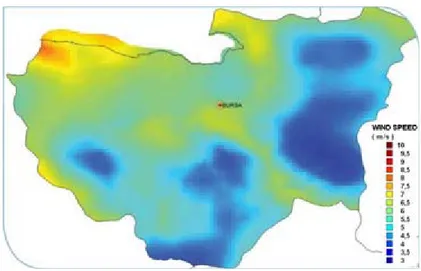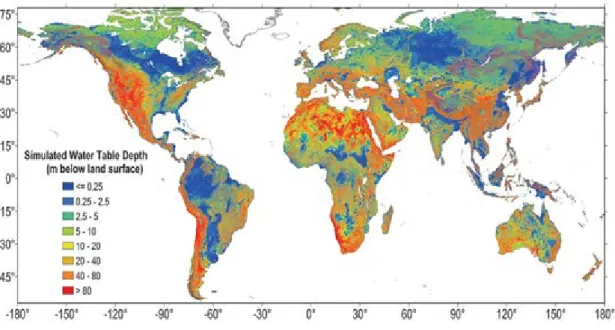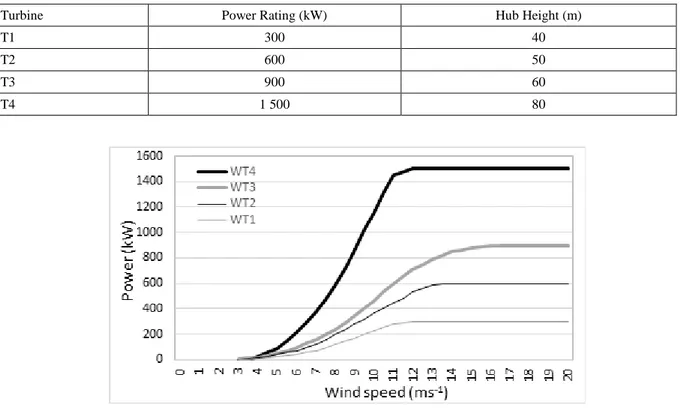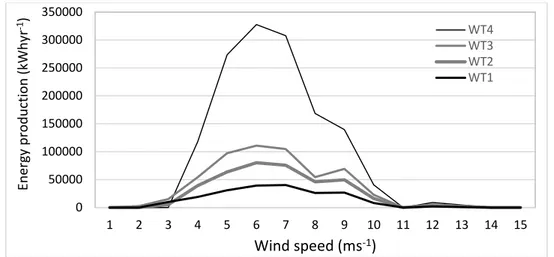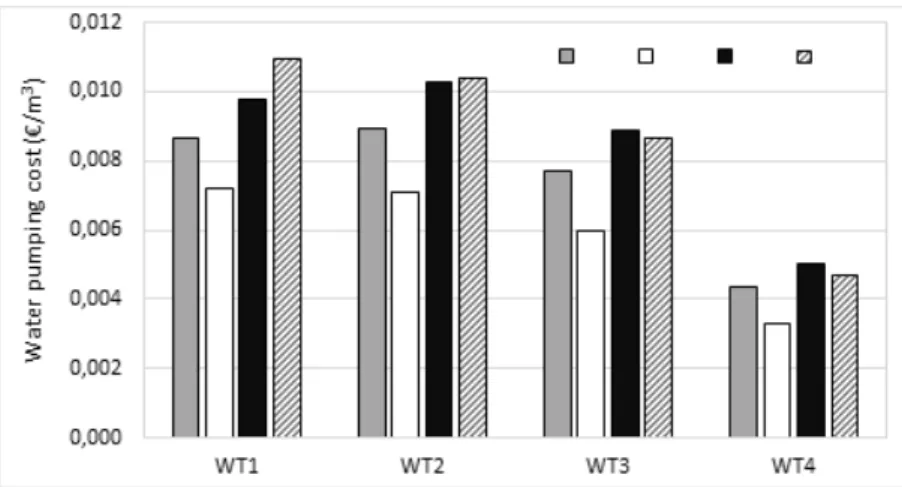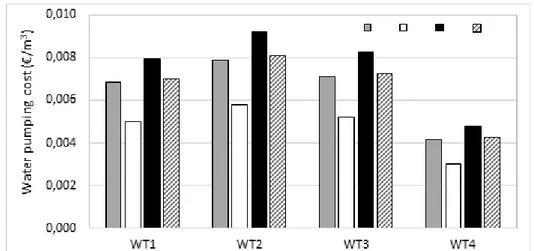https://dergipark.org.tr/tr/pub/bursauludagziraat http://www.uludag.edu.tr/ziraatdergi
Aralık/2020, 34(2), s. 287-301
ARAŞTIRMA MAKALESİ RESEARCH ARTICLE
Geliş Tarihi (Received): 25.03.2020 Kabul Tarihi (Accepted): 09.06.2020
Technical and Economic Analysis of the Use of Wind Energy for Water
Extraction: Karacabey Example
AErkan BÖLÜKBAŞ
1,
Tuğba BİÇEN
2, Ali VARDAR
3*Abstract: One of the problems that occur with the increase of the world population is the limited energy resources. The rapid depletion of fossil resources and increasing energy consumption have led human beings to explore new sources of energy. In the 21st century, the greatest alternative to fossil resources was renewable energy sources. One of the areas where energy needs are technically and economically important is agricultural activities. Renewable energy sources have been used for many years to meet the energy requirements for agricultural activities such as grinding of grains and water extraction from wells. One of these sources is wind energy. In this study, it is aimed to determine the cost and availability of the energy needed for the removal of groundwater to the surface for use in agricultural irrigation in Bursa/Karacabey region in Turkey by using wind turbines. Study; using the data measured at the meteorological station Karacabey wind speed; 300, 600, 900, 1500 kW wind turbines and the use of power and energy that can be obtained in the case of submersible pumps with some selected values of availability, the cost and amount of water that can be pumped for the analysis are reviewed. As a result of the study, it was determined that the energy to be used to supply groundwater with submersible pumps in Karacabey region can be supplied from wind energy and this situation is quite economical compared to using mains electricity.
Keywords: Agricultural irrigation, water pumping, cost, wind turbine.
A
Bu makalenin bir bölümü Erkan Bölükbaş’ın Yüksek Lisans Tezinden türetilmiştir.
*
Sorumlu yazar/Corresponding Author: 3Ali VARDAR, Bursa Uludağ Üniversitesi, Ziraat Fakültesi, Biyosistem
Mühendisliği Bölümü, Bursa, Türkiye, dravardar@uludag.edu.tr, OrcID 0000-0001-6349-9687
1
Erkan BÖLÜKBAŞ, Bursa Uludağ Üniversitesi, Fen Bilimleri Enstitüsü, Biyosistem Mühendisliği Anabilim Dalı, Bursa, Türkiye, erkan.bolukbas4@gmail.com, OrcID 0000-0003-4004-7623
2
Tuğba BİÇEN, Bursa Uludağ Üniversitesi, Fen Bilimleri Enstitüsü, Biyosistem Mühendisliği Anabilim Dalı, Bursa, Türkiye, bicentugba@gmail.com,OrcID 0000-0001-6826-2494
Atıf/Citation: Bölükbaş, E., Biçen, T., Vardar, A., 2020. Technical and Economic Analysis of the Use of Wind Energy for
Su Çıkarma Amaçlı Rüzgar Enerjisi Kullanımının Teknik ve Ekonomik Analizi:
Karacabey Örneği
Öz: Dünya nüfusunun artışıyla beraber ortaya çıkan problemlerin başında enerji kaynaklarının sınırlılığı gelmektedir. Fosil kaynakların hızla azalması ve artan enerji sarfiyatları insanoğlunu yeni enerji kaynaklarının araştırılmasına sürüklemiştir. 21. yüzyılda fosil kaynaklara en büyük alternatif ise yenilenebilir enerji kaynakları olmuştur. Enerji ihtiyacının gerek teknik gerekse ekonomik anlamda önem arz ettiği alanlardan birisi de tarımsal faaliyetlerdir. Tahılların öğütülmesi, kuyulardan su çekilmesi gibi tarımsal faaliyetler için gerekli enerji ihtiyacını karşılamak için eski yıllardan beri yenilenebilir enerji kaynaklarından yararlanılmıştır. Bu kaynaklardan biri de rüzgâr enerjisidir. Bu çalışmada; Türkiye’de Bursa/Karacabey yöresinde tarımsal sulamada kullanılmak üzere, yer altı suyunun yüzeye çıkarılması işlemi için gerekli enerjinin, rüzgâr türbinleri kullanılarak elde edilebilirliği ve maliyetinin ortaya konulması amaçlanmıştır. Çalışmada; Karacabey meteoroloji istasyonunda ölçümü yapılan rüzgâr hızı verileri kullanılarak; 300, 600, 900 ve 1500 kW gücünde rüzgâr türbinlerinin kullanılması durumunda elde edilebilecek güç ve enerji değerleri ile seçilen bazı dalgıç pompaların kullanılabilirliği, pompalanabilecek su miktarı ve maliyetine yönelik analizler yapılmıştır. Çalışma sonucunda; Karacabey yöresinde dalgıç pompalarla yeraltı suyu teminini gerçekleştirmek için kullanılacak enerjinin, rüzgâr enerjisi kaynaklı olarak sağlanabileceği ve bu durumun şebeke elektriği kullanmaya kıyasla oldukça ekonomik olduğu tespit edilmiştir.
Anahtar Kelimeler: Tarımsal sulama; su pompalama; maliyet; rüzgar türbini.
Introduction
The world population and the demand for energy are constantly increasing over time. However, the reserves of fossil-based energy resources that we commonly use are decreasing and sustainability problems arise. These problems include CO2 emissions, air pollution and greenhouse gases. The solution to the problems arising in this
context is the use of renewable energy sources. It is anticipated that renewable energy sources from solar, wind, hydrogen and biomass will come to the fore to reduce both the above-mentioned problems and the greenhouse effect (Ragauskas et al., 2006).
Another important effect of population growth is the consumption of water resources. The total amount of water in the world has been determined to be 1.4 billion km3. 97.5% of this water is salty in oceans and seas, and 2.5% is found in rivers and lakes as fresh water. Considering that 90% of the fresh water resources are limited in the underground and poles, the amount of fresh water that human beings can benefit is quite low (Anonymous, 2014). A total of 46 billion m3 of water is consumed annually in Turkey, of which 15% is used as drinking and using water, 11% for industrial purposes and 74% for agricultural irrigation. In parallel with the increase in
Energy resources used during the consumption of water resources are also one of the factors in the efficient use of water resources. When Turkey's electricity consumption is examined, it is seen that the electric energy used in agricultural irrigation is more than the electric energy used for lighting (Anonymous, 2019a). Irrigation methods, plant type, soil type, climatic characteristics, pump, water supply and power supply type factors can change the level of energy consumption in agricultural irrigation. Approximately 90% of unit irrigation input energy is operational and 10% is installation energy (Çalışır, 2008).
The aim of this study is to be realized efficiently the agricultural irrigation in Karacabey region (Bursa, Turkey). In this context, it is thought that the energy needs of the submersible pumps to be used can meet from the potential of wind energy in the region. In this case, it is aimed to determine the ideal “turbine – pump combination” if four different capacity wind turbines and four different capacity submersible pumps suitable for local groundwater depths are used in an irrigation system.
Research Area
Determining the wind potential of the research area is very important for this study. In this context, the Wind Energy Potential Atlas (REPA) within the General Directorate of Renewable Energy was taken into consideration within the scope of the study. REPA is a Wind Atlas produced as a result of three separate numerical weather analysis models to cover all land and sea areas of Turkey's geography, to be run backwards with meteorological parameters that have been realized for many years. One of the main objectives of this wind atlas is to facilitate access to wind resource information for investors wishing to invest in wind energy (Anonymous, 2018b). There are multiple maps created by REPA. These maps covering the General of Turkey and 50 m high wind speeds showing the map is given in Figure 1. The version of the same map prepared in the provincial dimension and showing the wind potential of Bursa province is presented in Figure 2.
Figure 2. Wind speed distribution of Bursa - 50 m (Anonymous, 2019b)
Water Resources
It can be said that irrigation is the biggest factor of high quality and quantity crop cultivation in agriculture. The aim of irrigation is to provide needed water by artificial means in a sufficient amount and in a timely manner during the development periods of plants.
Groundwater resources are utilized in conditions where the water resources transmitted by natural means are insufficient or where transmission is not economical. Groundwater sources can be used directly for irrigation or stored in a higher area than the area of use and then used. In such cases, pumping plants are used in pressurized irrigation systems. Pumping plants include mechanical systems that convert energy such as pumps and motors and absorb energy such as pipelines.
In order to use irrigation water more effectively, pressurized irrigation system is essential. However, the high energy cost of pressurized irrigation systems is the biggest limiting factor in using these systems (Çalışır and Eryılmaz, 2005; Çalışır, 2008; Çalışır, 2010).
Groundwater occurs when water that falls or is found on Earth surface usually as rainfall, seeps underground by the effect of gravity and accumulates in the lower layers of the surface. Groundwater can be found in a fluid or stationary state. The major nutritional source of these waters is rainfall. Acording to the slope of the surface, vegetation and water permeability characteristics, the amount of groundwater and the degree of proximity to the earth are determined. These resources meet the water needs of cities, basins and industrial facilities.
The most important factor affecting the operation of groundwater; is the proximity of the source to the surface. The average groundwater depth in Turkey varies between 40 - 80 m, as can be seen in Figure 3 (Anonymous, 2013).
Figure 3. Groundwater depth table of world (Anonymous, 2013)
Most geographic regions have underground sources. Multiple methods can be used to exploit these resources. However, today, the most efficient method is to drill wells at the appropriate depth and remove the water to the desired level by means of pumps used in the well bottoms. Pumps that operate in this way are called submersible pumps. Submersible pumps are a special type of multistage mixed flow centrifugal pump combined with a water-resistant electric motor (Yalcin, 1998).
Material and Method
The location selected for this study is the Karacabey district of Bursa, located in the north-west of the Anatolian geography. Agricultural irrigation in this region is aimed to be realized in an economic way. In this context; it is aimed to determine the “ideal turbine-pump” combination in case of using four different capacity wind turbines and submersible pumps with four different capacities suitable for the local groundwater depths. Wind data, wind turbine and pump specifications for the region that made up the material of the study are given below.
Bursa/Karacabey wind data was provided by Karacabey Meteorological Station Number 17673. Daily averages of hourly wind speed data obtained from the station and covering 8 years were used. In the light of these data, wind values of different months were compared and wind frequency tables were formed according to the results.
Four different wind turbines have been compared for the energy solution projected to be applied to the region. These turbines differ in terms of power values, hub heights and brands and models. The power values of the selected wind turbines are in the range of 300 - 1500 kW. Hub heights are between 40 - 80 m. The characteristics of the selected turbines are given in Table 1 and Figure 4.
Table 1. Wind turbines and properties
Turbine Power Rating (kW) Hub Height (m)
T1 300 40
T2 600 50
T3 900 60
T4 1 500 80
Figure 4. Power curve of wind turbines (Anonymous, 2019d)
Four submersible pumps of the same brand, at different models and features, were selected for operation in combination with the selected wind turbines. According to the maps and analyzes prepared by World-wide Hydrogeological Mapping and Assessment Program (Anonymous, 2015), the groundwater level for Bursa/Karacabey region was determined as 50 m on average. According to this data, the use of submersible pumps suitable for pumping water from a depth of 40-60 m was foreseen and different flow models of these heights were included in the study. Specifications for selected submersible pumps are given in Table 2.
Table 2. Selected submersible pumps and features (Anonymous, 2019c)
Pumps Manometric Height
(m) Pump Efficiency (%) Flow Rate (m³/h) Engine Power (kW) P1 40 60,1 4,39 1,15 P2 40 61,1 20,9 4,0 P3 60 61,9 5,09 1,55 P4 60 62,9 20,5 5,5
The equations used to determine the wind speed value that wind turbines will need to operate the pumps to be used for irrigation are as follows (Shata and Hanitsch, 2006; Ilinca et al., 2003). Wind speed, rotor cross-section,
rotor Power coefficient, wind turbine mechanical efficiency and a specific gravity of air are the values that are important in this section (Piggott, 2004).
𝑃 = 0.5 ∙ 𝜌 ∙ 𝐴 ∙ 𝑣3∙ 𝐶
𝑃∙ 𝜂 (1)
A = π ∙ r2=π ∙ D2
4 (2)
Mechanical losses in wind turbines are minimized in the latest technologies. Therefore, mechanical losses in this study are not included in the calculations. Accordingly, equation (3) can be revised as follows:
𝑃 = 0.5 ∙ 𝜌 ∙ 𝐴 ∙ 𝑣3∙ 𝐶
𝑃 (3)
The wind velocity values obtained from Karacabey meteorological station for this study belong to a height of 10 m. Since the hub heights of selected wind turbines are different, the data in hand must be adapted to the relevant wind turbine hub heights. At this stage, the following equation was used (Klug, 2001; Özgener, 2006):
𝑣(ℎ) =𝑢𝑘 ∙ ln∗ 𝑧ℎ
0 (4)
For this study;
* There are no mechanical losses in wind turbines, * Air density is 1.225 kg/m3,
* Rotor Power coefficients (CP) is 0.45,
* The surface roughness coefficient is also considered to be 0.4 (Vardar and Eker, 2004; Bencuya İpekçioğlu and Vardar, 2017).
* Standard roughness classes were used as roughness classes (Elkinton et al., 2006).
To wind potential of a region where wind turbines will be installed; sea, open land, open sea, closed land, hills or hills are known to have a direct effect. In this study, evaluations were made as open terrain both in terms of using submersible pumps and to be suitable for agricultural activities. The economic life of wind turbines has been accepted as 25 years.
Two different scenarios are presented in the economic analysis. These scenarios are “supplying energy from the electricity grid” and “supplying energy from wind turbines”. The second scenario is divided into two different scenarios. In one of these, the cost of the pump is included. In the other, it is assumed that the cost of the pump is met from the own capital of the agricultural enterprises and the pump costs are not included in the calculations. The official tariffs of the state were taken into account as the district's agricultural irrigation-based water unit price (Anonymous, 2018a) and agricultural irrigation-based electricity unit price (Anonymous, 2019e). Wind turbines and submersible pump prices were determined by market research.
Result and Discussion
The following results were obtained according to the technical specifications of the four different wind turbines and four different irrigation pumps mentioned in the material section and by applying the related methods:
The average values of wind speeds measured at a height of 10 m at Karacabey meteorological station were used for calculations based on the core heights of wind turbines planned to be used in the irrigation system. The wind speed values obtained as a result of the calculations are seen in Figure 5. The calculated correction factor for average values is 1.45.
Figure 5. Monthly average wind speeds at different heights with a correction factor
The maximum average wind speed values were reached in August, while the minimum average wind speed values were obtained in November. The highest wind speed is 7.7 m/s and the highest wind power is 282.7 W/m2 for the 233rd day of the year (in August). Furthermore, it is observed that the wind speed increases periodically between 200 and 240 days of the year (July-August period). In addition, the lowest wind speed was 1.9 m/s and the lowest wind power was 4 W/m2 on the 348th day of the year (in September). It can be said that the year-end and New Year wind speed measurement values are periodically lower.
Table 3 shows the power values that can be obtained from four different wind turbines monthly if selected within the scope of the study and installed in the Bursa / Karacabey region.
In August, the available power value is higher than in the other months, while the power available in November is lower. The average power value for WT1 turbine is 52.6 kW, 90.8 kW for WT2 turbine, 151.6 kW for WT3 turbine and 433.7 kW for WT4 turbine.
Table 3. Power values that can be obtained from selected turbines T1 T2 T3 T4 W/m2 kW W/m2 kW W/m2 kW W/m2 kW January 37.2 34.6 42.9 72.0 47.9 108.0 56.6 309.0 February 59.6 61.7 68.7 123.7 76.8 180.6 90.8 525.4 March 45.9 43.1 52.9 8.8 59.1 138.0 69.9 377.0 April 40.1 38.2 46.2 76.2 51.6 120.0 61.0 326.0 May 36.1 34.6 41.6 69.3 46.5 108.0 54.9 292.0 June 56.1 55.5 64.6 17.6 72.2 164.2 85.4 483.0 July 91.8 105.3 105.8 204.3 118.2 278.8 139.8 828.4 August 117.3 139.2 135.2 260.7 151.1 352.6 178.7 1044.5 September 43.4 40.0 50.0 84.6 55.9 126.0 66.1 360.0 October 35.5 32.8 41.0 69.3 45.8 102.0 54.1 292.0 November 20.9 18.7 24.1 41.5 26.9 54.6 31.8 137.8 December 30.0 27.4 34.5 61.2 38.6 86.8 45.6 229.6 Average 51.2 52.6 59.0 90.8 65.9 151.6 77.9 433.7
Figure 6 shows the relationship between wind speed and energy generation for selected wind turbines.
Figure 6. The relationship between wind speed and energy production of turbines
According to the results obtained by using meteorological data in Bursa/Karacabey region; With WT1 turbine 203421 kWh/year, WT2 turbine with 381384 kWh/year, WT3 turbine with 540207 kWh/year and WT4 turbine with 1388847 kWh/year energy production can be realized. Maximum in the same region; 40404 kWh/year at 8.6 m/s wind speed with WT1 turbine, 80136 kWh/year at 7.5 m/s wind speed with WT2 turbine, 110880 kWh/year at 7.8 m/s wind speed with WT3 turbine, and 327600 kWh/year at 8,2 m/s wind speed with WT4 turbine, energy will be production were determined. Table 4 shows the amount of water that can be pumped with the selected wind turbines.
0 50000 100000 150000 200000 250000 300000 350000 1 2 3 4 5 6 7 8 9 10 11 12 13 14 15 Ene rg y pr oduc tio n ( kW hyr -1)
Wind speed (ms
-1)
WT4 WT3 WT2 WT1Depending on the regional wind characteristics, the results obtained by comparing the average monthly power values of the wind turbines selected in the study and the motor powers of the pumps selected in the study are shown above. According to the results obtained; July and August are the times when the most pumps can be operated and the most water can be pumped.
Economic Analysis
In the economic analysis part of the study, two different scenarios are presented. These are the scenarios of “supply of energy needs from electricity grid” and “supply of energy needs from wind turbines” respectively. According to the first scenario mentioned here (providing energy needs from the power grid), water pumping costs of four different pumps are given in Figure 7, taking water costs into consideration.
Figure 7. Water pumping costs if electricity needs are supplied from the electricity grid
The lowest cost per cubic meter of water was obtained from the IP2 pump with 0.0384 €/m3 and the highest cost was obtained from the IP3 pump with 0.047 €/m3.
The second scenario; “Providing energy needs from wind turbines” scenario. This scenario is divided into two different scenarios. One of these is the scenario “including the cost of the pump”. Another scenario is that “the cost of the pump is covered by the own capital of agricultural enterprises and is not included in the calculations”. According to the scenarios mentioned here, water pumping costs of four different pumps are given in Figures 8 and 9, and taking water costs into account.
In the scenario where “energy needs are provided from wind turbines and the cost of pumps is included”; the lowest costs per cubic meter of water were achieved with the WT4 wind turbine with 0/0033-0/005 €/m3. The highest costs were obtained with WT1 wind turbine with 0/0072-0/011 €/m3. In this context, it is seen that this scenario is quite economical according to the first scenario where “energy needs are provided from the electricity grid”. When the costs per cubic meter between the pumps are examined, it is understood that the IP2 pump has the lowest costs in all wind turbines.
Figure 9. Water pumping costs (excluding pump charges) if energy is supplied from wind turbines
Similar results were obtained in the scenario where “the energy requirement is provided from wind turbines and the cost of the pump is met by the own enterprises' own capital and is not included in the calculations”. However, as the pump costs are not included, as can be expected, lower costs have arisen. In this context; The lowest costs per cubic meter of water were achieved with the WT4 wind turbine with 0.003-0.0048 €/m3. The highest costs were obtained with WT1 wind turbine with 0.0058-0.0092 €/m3. This last scenario is seen to be more economical than the scenarios where “energy needs are provided from the electricity grid” and “energy needs are provided from wind turbines and pump costs are included”.
Conclusion
In this research, the conditions of using electrical energy obtained from wind energy in irrigation pumps were evaluated. The results of wind turbines with rated power values of 300, 600, 900 and 1500 kW that can be used following wind potential and four different submersible pumps in the power range of 1.15-5.5 kW were examined.
According to the meteorological data in the Bursa/Karacabey region where the turbine-pumping system is planned to be established, the maximum electrical power can be obtained; in July and August. In July and
August, when the temperature increases and the water needs of the plants, in general, are directly proportional to the temperature, obtaining more energy for water pumping will be an agricultural advantage.
In case the groundwater depth of the application area is less than 40 m and low flow (4.39 m³/h) is required; 531-3986 m3/h water can be pumped in August with the energy that can be produced. On the other hand, it was determined that approximately 70-522 m3/h of water could be pumped with the same pump in November.
If the groundwater depth is less than 40 m above the surface and a high flow rate (20.9 m3/h) is needed, 711- 5455 m3/h water can be pumped in August with the energy that can be produced. In November, approximately 84-711 m3/h water can be extracted with the same pump.
When we look at the issue of water pumping for agricultural purposes from an economic point of view; if the energy needs are met from the electricity network, there are costs between 0.0384-0.047 €/m3 per cubic meter of water. On the other hand, in the case of the "supply of energy from wind turbines ", costs fall to 0.0033-0.005 €/m3 (including pump cost) and 0.003-0.0048 €/m3 (excluding pump cost).
According to the Chamber of Electrical Engineers 2019 data, the total annual Energy spent on lighting in Turkey for 2018 is 483 046 MWh, while the total annual Energy used for agricultural irrigation is 605 014 MWh. In fact, this data allows us to realize how much energy agricultural irrigation requires. Using renewable energy sources to defray such high energy requirements is also essential for sustainability and energy saving.
In this study, it is determined that if the wind energy, which is one of the renewable energy sources, is used in Bursa / Karacabey region, the energy needed in agricultural irrigation can be met economically. This study, if it is decided to implement shared energy-irrigation systems, agricultural product to be planted in the region, water requirement of agricultural product, local groundwater depth, such as the elements taken into consideration, especially wind turbine and submersible pump type will provide important contributions to the choice of the application is evaluated.
Acknowledgment
Bursa/Karacabey wind data were provided by Bursa/Karacabey Meteorological Station number 17673. We would like to thank the General Directorate of Meteorology and the Bursa/Karacabey Meteorological Station. All authors participated in the conception of the topic. All authors read and approved the final manuscript after critically revising it for important content The authors declare that there is no conflict of interest regarding the publication of this article.
References
Anonymous, 2013. Global patterns of groundwater table depth. Science, 339: 942.
Anonymous (2014). World water resources. http://www.dsi.gov.tr/toprak-and- water- resources (Access Date: 15.07.2019).
Anonymous, 2015. Global groundwater vulnerability to floods and droughts would-wide. Hydrogeological Mapping and Assessment Program, Paris.
Anonymous (2018a). Water Usage Service Tariffs to be Applied in Irrigation Facilities Operated by Irrigation Unions in 2019, Republic of Turkey Ministry of Agriculture and Forestry, State Hydraulic Works Operation and Maintenance Department, http://www.dsi.gov.tr/docs/unim-fiyatlar/su-kullan% C4% B1m_-service - cost - tariffs.pdf? Sfvrsn = 0 - (Access Date: 15.07.2019).
Anonymous (2018b). Turkey wind energy potential atlas. http://www.yegm.gov.tr/YEKrepa/REPA-duyuru_01.html (Access Date: 05.10.2019).
Anonymous, 2019a. 2019 Energy Statistics. Chamber of Electrical Engineers, Ankara.
Anonymous (2019b). Bursa wind source information. http://www.yegm.gov.tr/YEKrepa/BURSA-.REPA.pdf - (Access Date: 10.07.2019).
Anonymous (2019c). Submersible groundwater pumps. https://en.grundfos.com/products/find-product/sp.html - (Access Date: 10.07.2019).
Anonymous (2019d). Wind turbines power curve. https://en.wind-turbine-models.com/powercurves - (Access Date: 10.07.2019).
Anonymous (2019e). Tariff Tables Based on Electricity Bills, TC Energy Market Regulatory Authority. https://www.epdk.org.tr/Detay/Icerik/3-1327/electric-bills-esas- tariff-tables - (Access Date: 05.10.2019). Bencuya İpekçioğlu, R.G. and Vardar, A. 2017. Turkey’s 2017 Actual Wind Energy Appearance. Bursa Uludağ
Üniv. Ziraat Fak. Derg., 31 (2), 177-181.
Çalışır, S. 2008. Efficiency in irrigation pump plants. Groundwater and drought conference in Konya closed basin, T.C. Ministry of Environment and Forestry General Directorate of Giants Water Affairs 4th Regional Directorate, Proceedings, 270-275, Konya.
Çalışır, S., 2010. The Effect of Impeller Outlet Section on Pump Operation Characteristics in Submersible Irrigation Pumps, Journal of Agricultural Machinery, 6(3): 163-170.
Çalışır, S., Eryilmaz, T. 2005. The effect of the direction of rotation on the system efficiency of submersible pumps used in irrigation, Journal of Agricultural Machinery, 1(2): 123-134.
Elkinton, M.R., Rogers, A.L., McGowan, J.G. 2006. An investigation of wind shear models and experimental data trends for different terrains. Wind Engineering, 30(4): 341-350.
Kaya, Ç.I. 2010. The effects of different irrigation strategies applied by using drop and fresh water with drip system in the Mediterranean region on the salt accumulation in the soil with the yield of quinoa plant and testing the saltmed model. Master Thesis, Cukurova University, Institute of Science and Technology, Faculty of Agriculture, Department of Agricultural Structures and Irrigation, Adana.
Klug, H. 2001. Basic course in wind energy. German Wind Energy Institute, Istanbul, Turkey.
Özgener, Ö. 2006. A small wind turbine system (SWTS) application and its performance analysis. Energy Conversion and Management, 47: 1326-1337.
Piggott, H. 2004. Small Wind Turbine Design Notes, http://www.scoraigwind.com, Denmark - (Access Date: 02.08.2003).
Ragauskas A.J., Williams, C.K., Davison, B.H., Britovsek, G., Cairney, J., Eckert, C.A., Tschaplinski, T. 2006. The path forward for biofuels and biomaterials. Science (New York, N.Y.), 311(5760): 484-9.
Shata, A.S., Hanitsch, R. 2006. Evaluation of wind energy potential and electricity generation on the coast of the Mediterranean Sea in Egypt. Renewable Energy, 31(2006): 1183-1202.
Vardar, A., Eker, B. 2004. Marmara Region Wind Potential, Energy Monthly News and Research Journal, 8: 34-36.

